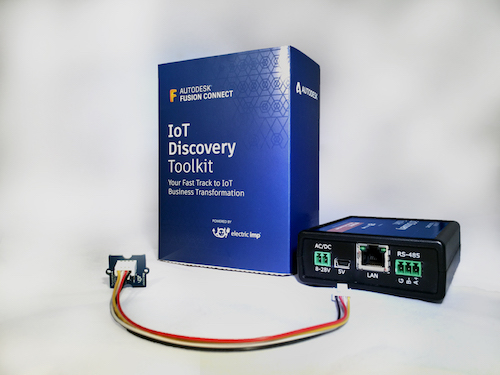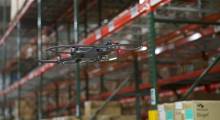For many developers, building the next-generation of Internet of Things (IoT) connected products is a lot like pushing on a rope. Trying to balance the complexity of hardware and connectivity choices with embedded software requirements and security demands is beyond the scope of many organizations that want to move forward with IoT, but simply don’t have the know-how to get past the starting block.
Autodesk, in partnership with Electric Imp, a IoT platform focused on secure connectivity to devices, has released the IoT Discovery Toolkit designed to take some of the sting out of early prototyping. The packaged solution includes a Wi-Fi-enabled gateway, grove connector cable, Autodesk Fusion Connect account with pre-defined business application templates, and an Electric Imp developer account with a pre-defined IDE framework, enabling devices and cloud applications to be easily managed. The idea is to help engineers and designers build out a secure end-to-end IoT prototype in a fraction of the time, using the same set of technologies that can support IoT development on a production scale, according to Lona Dallessandro, Autodesk’s business development leader for IoT.
 Autodesk’s IoT Discovery Toolset gives developers a head start in building connected products. Image Courtesy of Autodesk
Autodesk’s IoT Discovery Toolset gives developers a head start in building connected products. Image Courtesy of Autodesk“Our customers are spending a lot of time on how to connect devices up to machines and how to ensure they are secure,” she explains. “Now we’re starting to hear them talk about what to do with the data to transform the business. By partnering with Electric Imp, we are giving customers a quick and easy way to prototype so they can identify business value.”
By teaming up on an IoT toolkit solution, Autodesk and Electric Imp are providing key pieces to facilitate and simplify IoT product discovery and implementation in a single purchase, supported through resources by both partners. Many companies starting down the path to IoT get stuck in the concept and prototyping phase as they struggle with long lead times to figure out how to build out and secure the connectivity stack from the device all the way up to the cloud. “Think of Electric Imp as a secure pipe between the silicon in the device and the cloud,” says Hugo Fiennes, CEO and co-founder of the firm, explaining that in this case, the target is Autodesk Fusion Connect’s cloud-based IoT data management and analytics platform. “Until this, people did this themselves and unless you were an expert in security, a lot of people made mistakes.”
IoT Challenges Abound
While IDC is predicting the installed base of IoT endpoints to grow from 14.9 billion at the end of 2016 to more than 82 billion by 2025, the journey can be rocky, especially in the early concept stage. In fact, a recent Cisco study found that 60% of IoT initiatives stall at the proof of concept (PoC) stage and only 26% of companies consider their IoT initiatives to be a success. Another wake-up call: A third of all completed projects were deemed unsuccessful, according to the Cisco survey.
With the IoT Discovery Toolkit, Autodesk customers can get going on building IoT products and figuring out new revenue streams without hiring a crop of embedded software and connectivity experts and in lieu of protracted development cycles. “The value proposition of our joint approach is that you don’t have to hire a team of folks that know C++ or an IoT operating system—we abstract away the complexity of the hardware and take care of security,” says Bryan Kester, Autodesk’s head of IoT. “That means you can build your team appropriately and lower project costs.”
The IoT Discovery Toolkit doesn’t just stop at the prototype stage. Customers can port the prototype work into commercial product hardware with minimal modification as the device module, software, and cloud applications included in the IoT Discovery Toolkit are production grade.
To learn more about Electric Imp’s Internet of Things (IoT) play, check out this video.
About the Author
Follow Robotics 24/7 on Linkedin
Article topics
Email Sign Up
















